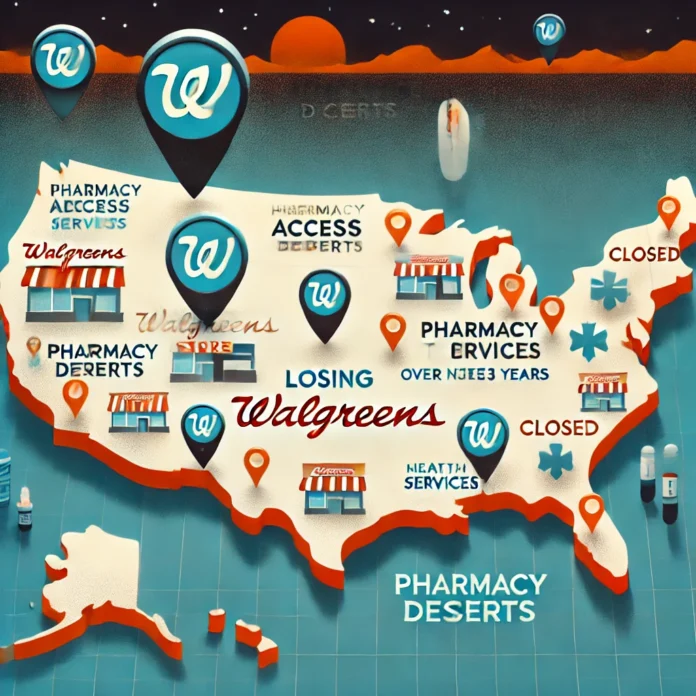
In a strategic move to streamline operations and mitigate financial losses, Walgreens, one of the largest drugstore chains in the U.S., has announced plans to close approximately 1,200 stores over the next three years. The closures will begin with about 500 locations in the current fiscal year. This decision follows a series of financial struggles, including significant losses in both retail sales and overall profitability. As the company embarks on this restructuring journey, questions arise about the future of its retail operations and the impact these closures may have on pharmacy access across the U.S.
Walgreens’ Financial Struggles and Declining Retail Sales
Walgreens is emerging from a challenging period marked by disappointing retail performance and major leadership changes. In the fourth quarter of the fiscal year, the company’s retail sales fell by 3.5% year over year, while full-year retail sales dropped by 4.6%. Comparable sales (comps), a key indicator of retail health, also saw declines—down 1.7% in Q4 and 3.4% for the full year.
Several factors contributed to this drop in retail sales, including underperformance in categories like beauty, seasonal goods, and general merchandise. These areas siphoned about 150 basis points from Walgreens’ Q4 comps, while elevated shrink levels—essentially, losses due to theft or damaged goods—further hurt the company’s retail adjusted gross margin. Despite some positive impacts from category mix and private label offerings, the overall retail outlook remains grim.
The Road to Store Closures
The announcement of store closures follows months of warnings from Walgreens’ CEO, Tim Wentworth, who indicated that underperforming stores and profitability challenges would necessitate drastic changes. According to Wentworth, around 25% of Walgreens’ 8,700 U.S. stores have been underperforming, putting them at risk of closure.
In its earnings presentation, Walgreens outlined its considerations for these closures, which include cash flow benefits, underperforming owned locations, and expiring leases. With a significant portion of its stores either owned or nearing the end of their lease terms, the company expects that these closures will be “immediately cash flow accretive” once costs are factored in. The sale of owned stores is projected to yield working capital and proceeds that could exceed the cash costs associated with closing locations.
However, this move is not without significant implications. The closure of 1,200 stores is more than half of the locations Walgreens acquired from Rite Aid seven years ago after their merger plans were abandoned. For many, the scale of these closures signals deeper challenges within the company’s retail operations.
Impact on U.S. Pharmacies and Healthcare Access
While Walgreens aims to strengthen its financial position, the closure of so many stores raises concerns about creating “pharmacy deserts”—areas where communities lose access to vital healthcare services, including prescription medications and basic health consultations.
Neil Saunders, Managing Director at GlobalData, commented on the gravity of the situation, stating that the closures highlight a company in trouble and attempting to “course correct” after years of neglecting the fundamentals of its retail operations. Saunders added that while closing underperforming stores may help Walgreens stabilize financially, the closures represent a significant admission of failure in the company’s growth strategy.
Many underserved and rural communities rely heavily on local pharmacies for healthcare, and losing a Walgreens location could severely limit their access to medications. This potential increase in pharmacy deserts could exacerbate healthcare inequalities across the U.S., leaving vulnerable populations without essential resources.
Walgreens’ Strategic Adjustments: A Path to Recovery?
Despite these challenges, Walgreens hopes that its strategy will pave the way for long-term financial health. The company’s plans for store closures are expected to help reduce operating costs and refocus resources on higher-performing locations. This restructuring also includes an emphasis on improving cash flow, with Walgreens estimating that store closures will yield benefits as leases expire and real estate is sold or repurposed.
In addition to cutting underperforming stores, Walgreens is likely to make changes to its retail strategy to attract more customers. The company’s recent push to expand its private label offerings and refine its product mix could be part of its efforts to boost profitability, despite the decline in some categories like beauty and seasonal items.
However, the retail landscape is becoming increasingly competitive, with major players like CVS and Amazon intensifying their foothold in the healthcare and pharmacy sectors. For Walgreens, finding ways to differentiate itself from its competitors will be crucial as it seeks to retain customer loyalty and recover from its recent financial struggles.
Looking Forward: The Challenges and Opportunities Ahead
Walgreens’ decision to close 1,200 stores is a significant step in addressing the financial difficulties that have plagued the company in recent years. While this move may help the drugstore giant cut costs and improve cash flow, it also highlights the broader challenges facing traditional retail pharmacies in an evolving marketplace.
With a growing emphasis on digital healthcare solutions and increasing competition from e-commerce giants, Walgreens must adapt to new consumer behaviors and technological advancements. At the same time, it must continue to address the operational inefficiencies that have contributed to its recent losses.
For many communities, especially those in underserved areas, Walgreens’ presence plays a vital role in providing healthcare services. As the company moves forward with its closures, it will need to balance its financial objectives with its responsibility to maintain access to essential healthcare for millions of Americans.
Conclusion
Walgreens’ store closures mark a pivotal moment in the company’s history, as it grapples with financial losses and operational challenges. With approximately 1,200 stores set to close over the next three years, the drugstore chain is taking bold steps to improve its financial outlook. However, these closures could leave many communities without access to crucial pharmacy services, raising concerns about the broader implications for healthcare access across the U.S.
As Walgreens navigates this restructuring period, it remains to be seen whether these strategic adjustments will be enough to turn the tide. For now, the company must focus on stabilizing its operations while addressing the growing needs of its customers in an increasingly competitive and digital healthcare environment.


